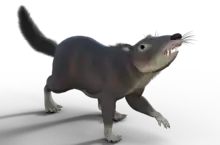Palaeoxonodon
Palaeoxonodon is an extinct genus of Cladotherian mammal from the Middle Jurassic of England[1] and Scotland.[2][3]
| Palaeoxonodon | |
|---|---|
| Scientific classification | |
| Kingdom: | Animalia |
| Phylum: | Chordata |
| Class: | Mammalia |
| Order: | †Amphitheriida |
| Family: | †Amphitheriidae |
| Genus: | †Palaeoxonodon Freeman, 1976[1] |
| Species: | †P. ooliticus |
| Binomial name | |
| †Palaeoxonodon ooliticus Freeman, 1976 | |
| Synonyms | |
| |
Discovery
The first fossils of Palaeoxonodon ooliticus were found in the Kirtlington cement quarry, Oxfordshire, England.[1] This site was rich in Mesozoic mammal remains from the Bathonian Forest Marble Formation. Later, two more species of Palaeoxonodon were named from the same site, P. leesi and P. freemani.[4] All of these fossils were individual teeth.
However, a recent fossil recovered from Scotland comprised a lower jaw with five molar teeth, four premolars, a canine and one incisor present.[2] This more complete fossil suggests that the separate species previously named from England were in fact all the same species, P. ooliticus, and only appeared different due to their differing position along the tooth row. This was also the case for Kennetheridium leesi.[4]
Two dentaries have recently been described.[3]
Description
Palaeoxonodon ooliticus, like most mammals in the Mesozoic, was relatively small. The most complete fossil jaw - from Scotland - measures 11.6mm, but does not include the very front or rear portions of the jaw. The living animal was probably around the size of a mouse and would have been insectivorous.
The teeth of Palaeoxondon have an elongate lower molar talonid, with hypoconid placed buccal to the midline of the crown, well-developed upper molar metacone and wing-like parastylar region.[2]
Taxonomy
Palaeoxondon belongs in the order Amphitheriida, closely related to Dryolestida. They are among the earliest Cladotherian mammals, which have their origins in the Middle Jurassic, and include the last relative of Amphitheriida, Dryolestida, Peramurida and Zatheria (which includes modern Therian mammals). Recent phylogenetic studies indicate that it was a sister taxon to Amphitherium itself.[3]
Biology
Compared to its closest relatives, Palaeoxonodon has rather slender jaws.[3]
References
- E. P. Freeman. 1976. Mammal teeth from the Forest Marble (Middle Jurassic) of Oxfordshire, England. Science 194(4269):1053-1055
- Close, Roger A.; Davis, Brian M.; Walsh, Stig; Wolniewicz, Andrzej S.; Friedman, Matt; Benson, Roger B. J. (2015-11-13). "A lower jaw of Palaeoxonodon from the Middle Jurassic of the Isle of Skye, Scotland, sheds new light on the diversity of British stem therians". Palaeontology. 59 (1): 155–169. doi:10.1111/pala.12218. ISSN 0031-0239.
- Panciroli E; Roger B.J. Benson; Richard J. Butler (2018). "New partial dentaries of amphitheriid mammalian Palaeoxonodon ooliticus from Scotland, and posterior dentary morphology in early cladotherians". Acta Palaeontologica Polonica. in press. doi:10.4202/app.00434.2017.
- Sigogneau-Russell D. 2003. Holotherian mammals from the Forest Marble(Middle Jurassic of England). Geodiversitas, 25, 501–537.





